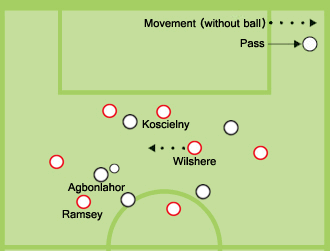At some point in the future, it will be known as the ‘Gabriel Agbonlahor paradox’; how one player, struggling to live up to his promise, inexplicably raises his game every time he faces Arsenal. The reason he enjoys playing against Arsenal, however, is because he’s readily able to expose one of Arsenal’s big flaws: the team’s vulnerability to the counter-attack.
The warning signs were there in pre-season where Arsenal were exposed continuously on the break by Napoli. Arsene Wenger expressed those concerns post-match saying that a midfield of Aaron Ramsey and Jack Wilshere “gave too much distance to Napoli’s players, and we marked them from too big a distance.”
However, at that time, that partnership was considered to be an experiment; a mock test of the midfield that we’re likely to see regularly deployed in the future. However, inactivity in the transfer market and injury to Mikel Arteta forced Wenger’s hand earlier and in the first game of the new season, the young duo started together in the heart of the midfield.
For 30 minutes they looked comfortable with Wilshere involved in the goal which gave Arsenal an early lead. But then the inexplicable happened, as Agbonlahor went on a mazy run and was later brought down by Wojciech Szczesny for a penalty. After Christian Benteke put in the rebound, Arsenal lost control. Aston Villa had countless breakaways opportunities in the second-half and as Arsenal failed to take their chances, Villa exposed them.
Defeat, and the way it happened, was a massive blow to the work Arsenal did last year and indeed, in pre-season on their shape. The Gunners are playing a formation that more closely resembles a 4-4-2 than the 4-3-3 that it did in previous years. There a number of reasons for this. Firstly, the players have changed. The old system was built around Cesc Fabregas and the direct passing style he brought, so Wenger has altered it so it suits the qualities of the players at his disposal. He says this is a team that flourishes on “a game based on very quick combinations” therefore moving to a 4-4-2 (4-2-3-1 might be better) allows the players to play closer to each other.
The second reason is that the pressing has changed. Tomas Rosicky works in tandem with Olivier Giroud to close down the defenders while their team-mates behind look to get tight to the opposition. The idea is that it then becomes more difficult to pass the ball through. Yet, the issue against Aston Villa was that there was a lack of tactical clarity when the ball did get through, particularly on the counter-attack.
A lot of it was Arsenal’s own undoing despite the fantastic game-plan that Paul Lambert executed. For Aston Villa’s second goal, Arsenal piled numbers forward but left no protection back when the visitors stole the ball off Santi Cazorla. The third goal was a carbon copy of the one Michu scored last December in the 2-0 defeat when Arsenal chasing the game, left nobody back for the corner-kick. For Koscielny’s second yellow-card, both full-backs got forward at the same time – something Arsenal had worked hard on to correct last season but it seems it’s less of a priority this season (judging by the pre-season games).
But to understand the malaise, one has to look at the way Arsenal conceded their first goal. There was simply nobody taking responsibility and by the time Arsenal realised Agbonlahor had drifted into a pocket of space, he was already running at pace at the heart of the defence and there was little time to react. Normally, there’d be Mikel Arteta there and players like Koscielny instantly feel more secure. Therefore it was probably naïve for Wenger to expect Wilshere and Ramsey to hold the midfield together in the first game of the season. In time it might work but the respective strengths of the two players are in a way, negated with Arteta.
Wilshere actually had the stronger game, attempting to hold his position and in rare moments we did see his trademark burst from defence. But he was the one who put Cazorla in trouble in the lead up to Aston Villa’s second goal with a square pass. And while Wilshere is a good passer, it probably should have been Ramsey who took the main responsibility for distributing as it suits him more (and he has played the position more recently). Instead he tried to resume the role that he played alongside Arteta, using his energy to break down attacks and driving forward when he should have held his position more.

Indeed, you can make the argument to say that Ramsey’s running to cause disorder only worked last season because he had, alongside Arteta, the balanced structure. For the lead up to Aston Villa’s first penalty, Ramsey was the one found wanting as he was caught up the pitch when Agbonlahor drove forward with the ball.
As a result, Wilshere was caught with acres of space to defend (and he probably should have adjusted his position quicker to meet Agbonlahor’s run. Instead, the Villa striker had all the momentum to skip away).
Arsenal’s unbeaten run at the end of last season was built on a pragmatic approach; a design based on efficiency, greater organisation and communication at the back (and very reliant on taking what little chances the team creates).
Starting Jack Wilshere and Aaron Ramsey together in midfield so early in the season was, even if he had little choice, a bit like ripping up that formula.


